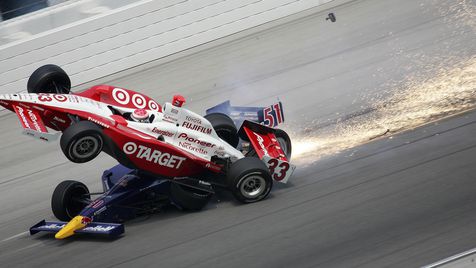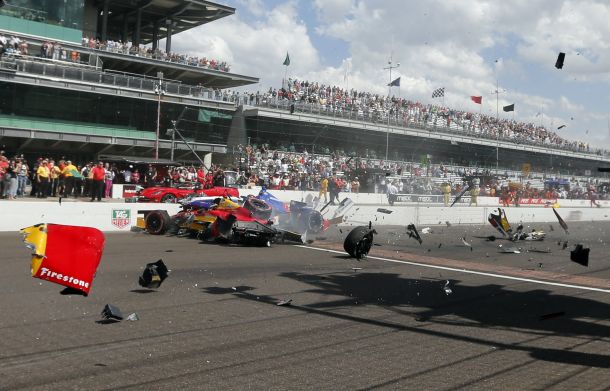It is not new that separate aerodynamic bodywork will be run on the cars of the IndyCar Series come the 2015 racing season, with Chevrolet and Honda each manufacturing their own aero kit for the teams to use; the new aero kits are due to be turned in for approval by INDYCAR from the teams on January 18 - a date that has quickly come up. Testing of prototype parts has been open since October 6 and will come to end on the homologation date, January 18. On the first of March, one road and street course/short oval kit will be delivered to each entrant, with the speedway kit being delivered on the first of the following month. Teams will first test the final kits on-track March 16-17 at Barber Motorsports Park, the track where one of the first IndyCar events of the year will take place. The aero kits for the road/street/short ovals will not be race-tested until March 27-29 at the Firestone Grand Prix of St. Petersburg. This will not be until the first oval race of the year that the speedway version of the kit will be run, which happens to be the 99th Running of the Indianapolis 500 on May 24.
A Q&A session took place with INDYCAR director of aerodynamic development Tino Belli shining light on legality and options the teams of the Verizon IndyCar Series have when it comes to these new aero kits. Apparently, differences between the cars run in 2014 and those we will see in 2015 will be evident to “an interested fan.” Belli also said, “It’s certainly not going to be a spec car, and it’s not even spec within the Chevrolet or Honda environments.” Therefore, the cars on-track in 2015 will be able to be differentiated between each other based on more terms than number or bright colors - to an interested fan.
On the safety side of things, advancements are in place to be added to the cars on top of the aforementioned aero kits. IMoreover, new additions such as a hole in the floor of the car should reduce surface area on the bottom of the car to prevent it from getting in the air and spinning/flipping midair during more serious accidents. Here is Ryan Briscoe going airborne at Chicagoland Speedway in 2005; it is accidents like this that fans of IndyCar should expect to see less from now on:

From LAT Photographic
Here's an example of the new hole cut in the floor from racer.com:
There are two updates being thrown onto the cars for the 2015 Verizon IndyCar Series season; there will be new generations of thigh panels and driver head surrounds (for ovals) added to the Dallara chassis for the racing in 2015.
Pockets for handles to adjust the anti-roll bar have been added to both panels to the driver's side while the driver is in the car. In 2014, both adjusters were located on the driver’s left. Interior panels of Expanded Polypropylene (EPP) are sandwiched between carbon fiber on both sides of the 2015 cars' cockpits, further protecting the drivers' thighs and pelvises.
A new addition of the area around the headrest for road/street courses was introduced last year to lessen the forces (G forces) applied to the drivers as they race around tighter tracks and, notably, street circuits where bumpy track conditions are common. Three separate-density layers of Confor foam will be added to the headrest surround for the oval races of the 2015 season.
In addition, further safety advancements are already planned for the near future:
Fans of Canadian driver James Hinchcliffe will likely never forget the scary moment that happened on the back-straightaway at the inaugural Grand Prix of Indianapolis (the same race that saw the scary accident due to the standing start with Sebastian Saavedra). Hinchcliffe was struck in the head by a piece of debris from another car with both driver and debris traveling at high speeds. Here is how it happened live -- but in a foreign language:
Immediately after this accident, INDYCAR began considering solutions. A fin of carbon fiber attached just in front of the driver’s head is in testing; its purpose would be to deflect debris. Drivers have taken to the Dallara simulator and the Indianapolis Motor Speedway in the fall to figure out how the fin would impact their line of sight while they race; different iterations have been tested, including single and side-by-side fins.
Another bit of testing has been underway; this one is especially interesting. During crashes, often times on road/street circuits, the steering wheel violently rotates, potentially injuring the driver. Injuries occur when the driver's hands come off the wheel and are then struck by a part of the wheel. Another common injury occurs when a finger/thumb is stuck in the steering wheel, which is then turned too far. Jeff Horton, INDYCAR director of engineering/safety, and INDYCAR medical consultant Dr. Terry Trammell have been involved in the testing of a potential solution. This solution could become reality and an addition to the cars after more testing - toward the end of the racing season per indycar.com.
Horton had this to say about the “potential solution”: “One of the potential solutions we’ve looked at is a steering damper, which basically is a shock mounted on the steering rack and pinion setup so any shock or excessive movement by the tire, which is transmitted through the track rod into the steering rack with the pinion ratio, makes the steering wheel move at an extremely high rate.”
He also had this comment on the numbers of the project: “It’s a difficult project because there are a lot of forces involved that have to be slowed down and diminished very quickly. Our target is to limit the rotation in the first 50 to 150 milliseconds to 90 degrees or less. That is a range in which a driver’s hands normally move, which shouldn’t put them out of position enough to cause an injury. In our study, 2,000 degrees per second relates to 6 or 7 inches per second on the rack.”
Quotes from indycar.com
It is great to see these interesting safety additions coming this racing season as well as things like the hole in the floor and the aero kits. In March, racing begins, and the championship run begins for the drivers of the Verizon IndyCar Series, but in four days from now, testing and the initial engineering of the aero kits will be due for INDYCAR inspection.
Also, in case the featured image of this story sparked enough interest, here is the video of the Sebastian Saavedra crash that happened in the first few seconds of Grand Prix of Indianapolis history:









































